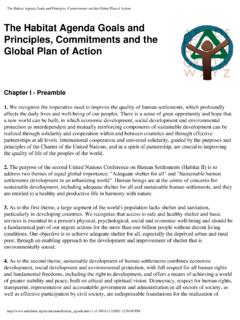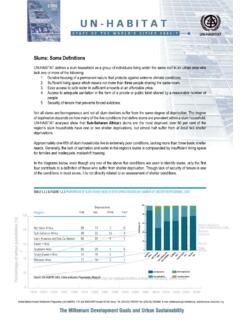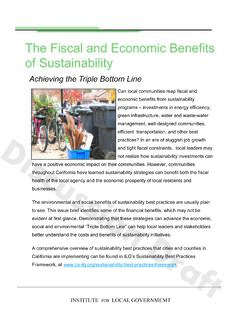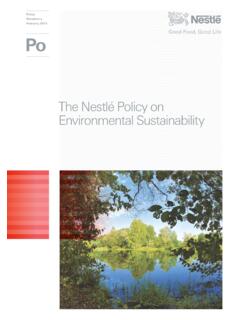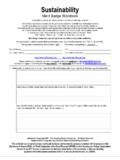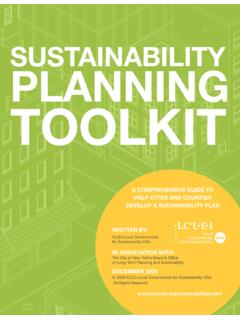Transcription of Urban planning best practices on urban planning
1 Urban planning best practices on Creating Harmonious Cities CITY EXPERIENCES Submitted to the expert group meeting. Rome, November 29 - 30th, 2007 Organized with the support of: This publication is available on-line: CONTACT DISCLAIMER: The designations employed and the presentation of material in this publication do not imply the expression of any opinion whatsoever on the part of the Secretariat of the United Nations concerning the legal status of any country, territory, city or area or its authorities, or concerning the delimitation of its frontiers or boundaries or regarding its economic system or degree of development. The analysis, conclusions and recommendations of this document do not necessarily reflect the views of the United Nations Human Settlements Program (UN-HABITAT), the Governing Council of UN-HABITAT or its Member States. Excerpts from this publication may be reproduced without authorisation, on condition that the source is indicated.
2 United Nations Human Settlements Programme (UN-HABITAT), 2008. INDEX Introduction 4 Bangalore, India 6 Barbados 9 Bogot , Colombia 13 Bossaso, Somalia 15 Clichy, France 19 Johanesbourg, South Africa 30 Nablus, Palestinian Territories 34 Nanjing, China 38 Pec / Peja UNMIK Kosovo 42 Tel Aviv, Israel 47 Meeting conclusions 50 INTRODUCTION This publication presents the main conclusions and experiences from selected cities discussed during the Expert Meeting Urban planning best practices on Creating Harmonious Cities held in Rome, Italy on 29 and 30th November 2007. Thirty experts from Local Government, Planners Associations and Universities gathered with the objective to exchange methodologies and experiences of Urban planning as a tool that can create sustainable urbanization, in other words harmonious cities . Harmonious cities will simultaneously generate economic growth, address Urban poverty and reduce the ecological footprint of the city.
3 Appreciation of the importance of Urban planning as a powerful tool to combat Urban poverty, social inequality and negative environmental change has been increasing over the past few years. In Europe, for example, new experiences on Urban planning are giving more and more importance to the impact of the city's shape on social, environmental and economic sustainability . New participatory techniques have been applied to the design and execution of Urban plans. When combined with effective strategic planning , Urban spatial plans can be excellent instruments to deal with change. In many developing countries, the lack of appropriate Urban planning can be pointed out as one of the major causes for poverty creation and increasing exclusion. Cities that develop chaotically see an increase in slums, lack of basic public services and leave the door open to exploitation of the weakest.
4 In developed countries there is an increasing concern about the negative impact of resource@wasteful forms of city development is having in terms of accelerating global climate change. Many economically fast developing cities of the developing world are also beginning to address this issue. Participants were selected amongst cities that submitted their experiences on the basis of the extent to which their planning approaches contribute to Urban sustainability in terms of maximizing their impact on key criteria, which included: Adaptation to climate change and reduced vulnerability to natural disasters Improving local and global ecology and environment, including mitigating climate change Improving housing conditions, particularly slums, and meeting Goal 7 Target 11 of the MDGs. Reducing Urban poverty and exclusion Contributing to rural@ Urban integration Reducing conflict and enhancing city safety Creating civic capital and promoting citizenship The above outcome criteria are derived from the paper on Reinventing planning considered at the World Urban Forum 2006 The above criteria are impact, not It is anticipated that successful experiences presented at the workshop are very likely to include considerations of Urban governance and popular participation, public@private@community partnerships, appropriate tools (land use regulation, infrastructure investment, transportation etc) amongst others.
5 However, the organizers are not prescriptive and the intention is to learn more about the most effective elements of planning processes that have stimulated Urban sustainability in reality. Amongst the submissions, a total of 10 cities were selected, trying to balance innovation, quality as well as geographical representation: Bangalore (India), Nanjing (China), Peja/Pe (UNMIK/Kosovo), Clichy (France), Tel Aviv (Israel), Nablus (Palestinian Territories), Bogot (Colombia), Bridgetown (Barbados), Bossaso (Somalia), Johannesburg (South Africa). The purpose of this publication is to offer to the general public these interesting experiences in the own words of the persons that have made possible the planning process. We would like to thank the Urban planning departments of Seville (Spain) and Rome (Italy) for their support and contribution to make possible this seminar. BANGALORE, INDIA Period of application of the Urban plan 2005 @ 2015 City population Approximately 7 million City area (in hectares) 130900 ha (1309 sq kms) CONTACT Participant s name Anjali Karol Mohan Institution Sattva Position Consulting Urban and Regional Planner e@mail Telephone +91 80 26631398, +91 9845514686 Address # 841, 37 F cross, 20th main, 4th T Block, Jayanagar, Bangalore 43, India Briefly describe the socio-economic background of your city (maximum 150 words) The City of Bangalore is the capital of the State of Karnataka, India and is a Metropolitan City.
6 Known for its Information Technology (IT) presence on the global map, the city in the last 2 decades has shown unprecedented growth owing largely to the impetus provided by the rapid emergence of the IT sector. Like any other sprawling and rapidly growing metropolitan economy in a transitional economy, the city faces the usual problems of a widening large gap between the requirement and the provision of the social and physical infrastructure provision. Not prepared for this unprecedented growth, the local government authorities have not been able to cope with this large gap between the demand and supply of public amenities and infrastructure. Furthermore with the city sprawl expanding, the gap is most felt in peri Urban Bangalore where not only are the Urban development, planning and management tools weak but also the densest areas in terms of population. With the authorities not able to service these fringes, unauthorized constructions and haphazard development is the hallmark in these areas; posing a real challenge to the Urban development managers and planners.
7 Briefly describe the most important features of the plan production process, emphasizing innovative aspects. (maximum 150 words) Mention other significant actors engaged in the process. The Revised Master Plan (RMP) for Bangalore has been unique as for the first time, the plan preparation process was outsourced to a private consortium under the Indo French Protocol with the objective of bringing in the state of the art technology in both planning and management of Bangalore Metropolitan Area. As such the plan has been innovative on several fronts (in context of the ongoing planning processes and the plans prepared so far in the country) as under: One, the RMP is based on a zoning strategy for a dynamic city fabric as against the static land use based physical plan. Two, it propagates a compact city model with future growth concentrated in the vacant parcels of the city centre (as against the existing tendency of a sprawl ) as a strategy to provide and manage efficient and cost effective amenities and facilities.
8 Third, the plan uses state of the art data repository created on GIS and its application to understand the dynamic fabric of the city. Four, the plan preparation process incorporated a Training and Capacity Building Module to transfer the process of plan preparation as also upgrade the skills of the planning authority. Five, it uses innovative tools like the Coordinated planning Scheme (CPS) to facilitate plan implementation. Lastly, for the first time ever, the city and its environs were ecologically mapped to enable an environmentally sustainable development. List and briefly evaluate the most important tools employed in plan production and implementation. Plan Production @ Evolving a GIS based data repository, establishment of the GIS based applications to enable regular updates on the data base. Developing the Gio Kosks for general public and the establishment of the Management Information Systems (MIS) for the planning authority to streamline the process of plan implementation.
9 Plan Implementation While detailed programmes and projects have not been evolved towards plan implementation, the consultants did detail out two specific tools in terms of the Transfer of Development Rights (TDR) and the CPS to facilitate balanced and timely development during the plan implementation, monitoring and evaluation phase. Name the 5 most important initiatives executed as a result of the plan 1. GIS based data repository complete, update to be taken up 2. Adaptation of the Zonal Regulation evolved in the plan preparation process to the building byelaws as prepared by the Local Government Agency the Bangalore Mahanagara Palika (BMP) ongoing 3. Rationalization of the TDR as being implemented by the BMP as against the TDR tool as laid out in the Plan and the Zonal Regulations Ongoing. 4. Implementation of the Metro rail transport system for the city of Bangalore Describe the Plan's achievements Adaptation to climate change, including reduced vulnerability to natural disasters Bangalore does not fall in the Seismic zone; hence the mandate of the plan was not to address the issues of Disaster mitigation and disaster preparedness.
10 Improving local and global ecology and mitigation of climate change, including reduction of greenhouse gas emissions While the city of Bangalore does not fall in a seismic zone, given Bangalore s unique micro climate composed of a 100 lakes, their watersheds and catchments, the planning process for the first time successfully recognizes this and has mapped the city ecologically defining the valley beds, the catchments and the watersheds as non buildable zones. The hierarchies and networks of the valleys have been established and demarcated to protect the valley systems of the city. Of course, while these have been mapped, a lot depends on the actual efficiency of the implementation process. Improving housing conditions, particularly slums, and meeting Goal 7 Target 11 of the MDGs. Housing typologies have been established to assist in evolving the zonal regulations. Additionally the plan earmarks the slum pockets in the city, though does not make any specific recommendation in terms of addressing the slum issue.
